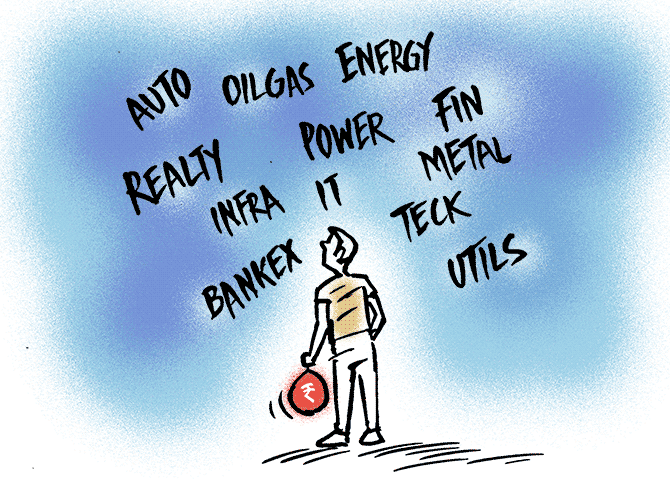The most consistent wealth creators since 2008 are all consumer-facing companies, says Devangshu Datta.
Illustration: Dominic Xavier/Rediff.com

The Motilal Oswal Annual Wealth Creation Study always offers interesting insights.
The study provides lists of the top 10 wealth creators in the last five years, the most consistent wealth creators, the fastest wealth creators, biggest wealth destroyers etc.
There are several takeaways for the long-term investor.
One is that the most consistent wealth creators since 2008 are all consumer-facing companies.
That list includes Titan, Godrej Consumer, Shree Cement, Pidilite, Maruti, Marico, Asian Paints, HDFC Bank, Kotak Mahindra Bank, and Dabur.
There are a few classic cyclicals (Maruti Suzuki, Shree Cement), two banks focussed on retail, FMCGs like Godrej Consumer, Dabur and Marico.
The connecting theme is a focus on serving Indian households.
In Maruti, Shree Cement and Asian Paints, you have big-ticket expenses.
In the case of Titan, it's luxury goods.
Or it may be daily/weekly consumption.
But household consumption is always a common factor.
It goes without saying that these firms have good stable managements.
A second important theme is that these were 'best buys' when the price/earnings (PE) to earnings growth or PEG ratios were below one.
Returns in terms of capital gains dropped consistently when PEG exceeded one.
The study used a five-year compounded annual growth rate or CAGR with perfect hindsight to illustrate this. Obviously an investor is making a guesstimate of future growth, which has error margins.
The study also pointed out a couple of counter-factuals and one area where shareholder returns may improve.
First, as it said, growth is not necessarily good if it comes with high cost of capital.
The specific ratio to look at is return on equity (RoE) versus cost of equity (CoE).
The CoE is the return a shareholder wants.
This CoE is considered equivalent to the Capital Asset Pricing Model (CAPM), which values a stock.
The CAPM is the risk-free rate of return (available from a bank fixed deposit (FD), or treasury yield) plus the beta of the stock multiplied into the equity premium (market index return minus risk-free return).
This sounds more complicated than it is conceptually.
Breaking it down, a stock investment is risky, so an investor wants a higher return than from risk-free assets.
The equity premium is the amount by which the market index return exceeds the risk-free return.
For example, if the treasury yield is 7.5 per cent and the Nifty is returning 9 per cent, the equity premium is 1.5 per cent.
The beta measures correlation and volatility of stock returns compared to the market.
A positive beta means the stock moves with the market, while a negative beta is counter-cyclical.
A beta of over 1 means that the stock moves more than the market.
Betas can change, but they can also be stable over time.
The CoE, or CAPM can, therefore, be calculated with a few assumptions and error margins using risk-free rate, beta stability, etc.
This can then be compared to RoE.
The study says that if RoE is below the CoE, even high earnings growth rates do not lead to higher capital gains in the long-term.
Staying on this theme of RoE, the study also points out the difference between the operational return on equity (profits from operations, as a ratio of equity) versus balance sheet RoE (total profits to equity) can be important.
In many cases, companies have excess cash on the balance sheet, which earns low returns.
This can drag down the balance sheet RoE.
In such instances, the company could reward shareholders through buybacks, enhanced dividends, etc.
It is exceptional for companies to maintain high RoE consistently.
Half of the universe of the top 1,500 listed companies had RoE less than 13 per cent.
Only 12 to 13 per cent of the sample had RoE over 25 per cent and that wasn't consistently the same companies.
Out of a set of 188 large companies in 1998, only 22 (roughly 12 per cent) maintained an RoE above 13 per cent for the next 20 years.
So the takeaways would be that the long-term investor should focus on consumer-facing companies.
S/he should be looking for businesses that do maintain consistently high growth and deliver RoE, which is higher than the CAPM.
S/he should also be looking to buy when she thinks the PEG is below 1.
In a bull market, that last criterion is hard to meet for decent businesses, but it's worth looking for.












 © 2025
© 2025